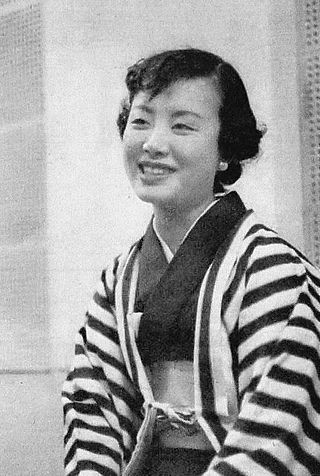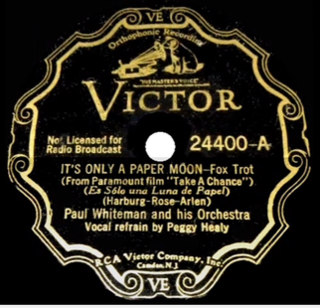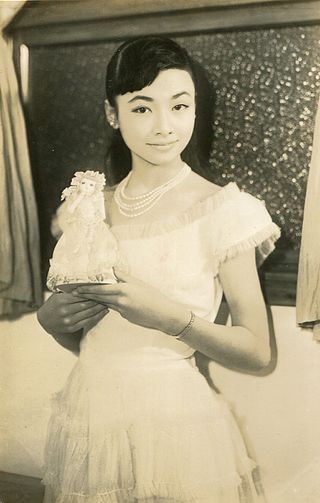Related Research Articles

Hibari Misora was a Japanese singer, actress and cultural icon. She received a Medal of Honor for her contributions to music and for improving the welfare of the public, and was the first woman to receive the People's Honour Award, which was conferred posthumously for giving the public hope and encouragement after World War II.
Ryūkōka is a Japanese musical genre. The term originally denoted any kind of "popular music" in Japanese, and is the sinic reading of hayariuta, used for commercial music of Edo Period. Therefore, imayō, which was promoted by Emperor Go-Shirakawa in the Heian period, was a kind of ryūkōka. Today, however, ryūkōka refers specifically to Japanese popular music from the late 1920s through the early 1960s. Some of the roots of ryūkōka were developed from Western classical music. Ryūkōka ultimately split into two genres: enka and poppusu. Unlike enka, archetypal ryūkōka songs did not use the kobushi method of singing. Ryūkōka used legato. Bin Uehara and Yoshio Tabata are considered to be among the founders of the modern style of kobushi singing.
"Walkin' My Baby Back Home" is a popular song written in 1930 by Roy Turk (lyrics) and Fred E. Ahlert (music).
"Till I Waltz Again with You" is a popular song written by Sid Prosen.
Kayōkyoku is a Japanese pop music genre, which became a base of modern J-pop. The Japan Times described kayōkyoku as "standard Japanese pop" or "Shōwa-era pop".
Saori Minami is a Japanese retired J-pop singer-songwriter. She was born in Okinawa on July 2, 1954. In the 1970s, and for about 6 years in 1991–1997 she was active as a pop musical idol.

"Vaya con Dios (May God Be With You)" (, literally "Go with God") is a popular song written by Larry Russell, Inez James, and Buddy Pepper, and first recorded by Anita O'Day in December 1952. Les Paul and Mary Ford had a No. 1 recording of the song in 1953. Members of the Western Writers of America chose it as one of the Top 100 Western songs of all time.

"It's Only a Paper Moon" is a popular song published in 1933 with music by Harold Arlen and lyrics by Yip Harburg and Billy Rose.

Shizuko Kasagi was a Japanese jazz singer and actress. At the peak of her fame in the immediate post-war era, she earned the nickname the "Queen of Boogie". Kasagi frequently sang songs composed by Ryōichi Hattori, including 1947's "Tokyo Boogie-Woogie", which remains her best-known work. Yoshinori Gyobe, a professor at Nihon University, said that with Hattori's bright boogie rhythms and Kasagi's lively singing of melodies that did not exist in Japan, the duo changed the image of Japanese music.

Chiemi Eri, was a Japanese singer and actress.
On Wings of Love is a 1957 Japanese romantic musical film directed by Toshio Sugie. It was Toho's highest-grossing film of the year and the first film released in Tohoscope.
Mari Amachi is a Japanese female singer and actress, who was famous in 1970s' Japan. On October 1, 1971, she debuted with the single "Mizuiro no Koi." She was born as Mari Saito in Omiya, Saitama Prefecture. She got five Oricon No.1 songs, a record as a female singer which was later broken by Seiko Matsuda. She started the era of Japanese idols in the 1970s and 1980s. Mari Amachi was the top female vocalist of Sony Music Entertainment in Japan.

Izumi Yukimura is a Japanese popular singer and actress.

So Young, So Bright is a 1955 color (Eastmancolor) Japanese musical film, directed by Toshio Sugie. This is the first of the so-called "three girl" series of films produced by Tōhō Studio, which involved teaming three popular young female stars of the period, employing a plot that portrayed their characters as best friends and recounted their romances and other adventures. This film was Toho's highest-grossing film of 1955.
Nobuyasu Okabayashi is a Japanese folk singer-songwriter whose career spans more than 50 years. Often compared to Bob Dylan, Rolling Stone Japan called him an icon of Japan's politically turbulent 1960s and 1970s. Okabayashi made his debut in 1968 and quickly earned the nickname the "God of Folk" with his protest songs. He spent 1975 to 1981 eschewing this title by experimenting with genres such as enka, pop, and new wave. Inspired by the rhythms of Japanese Bon Odori and Korean samul nori, he then created his own genre in the mid-1980s and 1990s that he dubbed "enyatotto" (エンヤトット).
Rumiko Koyanagi, formerly known as Rumi Natsukawa during her Takarazuka Revue days, is a Japanese actress and singer. She began her career as a member of Takarazuka Revue. She won the award for best new artist at the 13th Japan Record Awards and won the Japan Music Award in 1972. She won the award for best supporting actress at the 6th Japan Academy Prize for To Trap a Kidnapper and the award for best actress at the 7th Japan Academy Prize for Hakujasho.

Mission Over Korea is a 1953 American war film released by Columbia Pictures, directed by Fred F. Sears, from a story by former war correspondent Richard Tregaskis, author of Guadalcanal Diary. The film stars John Hodiak, John Derek, Audrey Totter and Maureen O'Sullivan.
Tadaharu Nakano was a popular Japanese baritone singer of jazz and ryūkōka in Shōwa era Japan.
The 58th Japan Record Awards (第58回日本レコード大賞) took place at the New National Theater in Tokyo on December 30, 2016. The ceremony was televised in Japan on TBS.
The 2nd Japan Record Award was held on December 30, 1960. They recognized musical accomplishments by performers for the year 1960. Kazuko Matsuo, Hiroshi Wada & Mahina Stars won the Japan Record Award, being the first duet that achieve the award. This is also the first time that the new artist award was given.
References
- ↑ Billboard - 14 Feb 1953 - Page 43 "Ditty was penned by Raymond Hattori, musical director for Nippon Columbia, and Benedict Meyers [sic], then an Army sergeant, and now a professor at Roosevelt College in Chicago. The disk was brought to the U. S. about two weeks ago by a record-happy sailor and received a strong reaction when played by deejay Ralph Storey on his KNX, Hollywood, deejay show. Paul Weston, of Columbia Records, sent an acetate of the disk to the main offices here, and the diskery arranged with ...
- ↑ Musical Leader - Volumes 84-85 - Page 16 1952 "Roosevelt College Professor Writes Japanese Song Hit When Benedict Mayers [correct], professor of political science at Roosevelt College, was serving as a sergeant in the occupation army in Japan, he wrote a poem called "Gomen Nasai" which means "Excuse Me." Raymond Hattori, a Japanese conductor, set the lyrics to music and immediately the song became a "hit." The Walt Disney " Music Co. won the American publishing rights. Record sales are running at about 4000 per month and ...
- ↑ Newsweek Volume 41 - Page 55 1953 "Columbia Records discovered that the platter had been cut by its affiliate in Japan. Last week it was rushing copies to the American market. "Gomen-Nasai" has English lyrics by Benedict Mayers [correct], now teaching at Roosevelt College in Chicago. When he wrote them he was an Army sergeant in Tokyo. His song concerns an errant lover with "a butterfly heart." The music, American ballad-type with a few pseudo-Oriental touches to the arrangement, was written by Raymond Hattori, ...
- ↑ Billboard - 7 Mar 1953 - Page 22 Vol. 65, No. 10 Memphis 2, Tenn. lite The Billboard classified «- ur RESULTS 1 FACULTY MAN IS LYRIC WRITER CHICAGO, Feb. 28. — The president of Roosevelt College here is boiling like a tea kettle. Edward J. Sparling, the prexy, complains, "What do I want with a song writer on my staff?" His assistant, Benedict Meyers [sic], wrote the lyrics to "Gomen Nasai," the Japanese ditty waxed by half a dozen record companies. Meyers has signed an American Society Composers, Authors and Publishers'
- ↑ Jet (magazine)- 29 Oct 1953 - Page 66 Vol. 4, No. 25 - After his recording of the song Gomen Nasai ("Forgive Me" in Japanese) while stationed with the Army in Tokyo last year, Bowers received Columbia record and movie contracts and the song became a juke box sensation. He sang it in the movie, Mission Over Korea. Bowers' latest Columbia recordings are entitled Baby, Let Me Kindle Your „. , . D Flame and Teardrops in the Rain. ^hard Bowers Other Negroes appearing on radio and television this week include: Ethel Waters on the ...
- ↑ Brian McAllister Linn Elvis’s Army 2016 - Page 292 0674973755 Army entertainers had a substantial impact on overseas musical tastes as well. The song “Gomen Nasai” that Leon Anderson heard on a record player at Fort Bragg was recorded in Japan by an American soldier. The song became such a success that it was released in the United States—truly a case of the army as a cross-cultural influence. Soldiers brought their dates to the NCO or other clubs to hear rock, country, or soul groups, and their dates took this music ...
- ↑ Michael K. Bourdaghs - Sayonara Amerika, Sayonara Nippon: A Geopolitical Prehistory of J-pop 0231158742 2012 "Postwar performances in America by Japanese singers, especially female singers, helped promote this new, softer image. For example, Eri Chiemi, who would later become part of the celebrated Three Girls (Sannin Musume) trio along with Misora Hibari and Yukimura Izumi, traveled to the United States in 1953. While there, she appeared in a charity concert with the Harry James Orchestra in Los Angeles, recorded the orientalist song “Gomen nasai” ...
- ↑ Shirley Jennifer Lim - A Feeling of Belonging: Asian American Women's Public Culture, 1930-1960 0814751938 2006
- In 1953, the same year that Kinuko Ito wore her much-praised dress with rosebud spray, the members of Chi Alpha Delta performed the Japanese song “Gomen-nasai” for UCLA's annual Spring Sing. “Gomennasai” had been sung by a Japanese artist, Chiemi Eri, who was touring the United States and who had recorded it in Los Angeles for Capitol Records. Profiled in the September 1953 issue of Scene, Eri had performed in Western dress, and the Chi Alpha Deltas also decided to ...
- ↑ Whitburn, Joel (1986). Joel Whitburn's Pop Memories 1890-1954. Menomonee Falls, Wisconsin: Record Research Inc. p. 219. ISBN 0-89820-083-0.
- ↑ Genia Fogelson Harry Belafonte 0870677721 1980 Page 53 Belafonte starred in his first movie, acted in major roles in two theatrical productions of worth and continued to be a success in nightclubs. Belafonte at this time became a father for the second time, met the woman who was to be his second wife, and broke with his dedicated manager Jack Rollins. After 1954, Harry's career and life would move at a breakneck pace. Early in 1953 Harry was asked to record a Japanese folk-type song, "Gomen-Nasai." Although Belafonte did not feel this ..
- ↑ Whitburn, Joel (1986). Joel Whitburn's Pop Memories 1890-1954. Menomonee Falls, Wisconsin: Record Research Inc. p. 49. ISBN 0-89820-083-0.